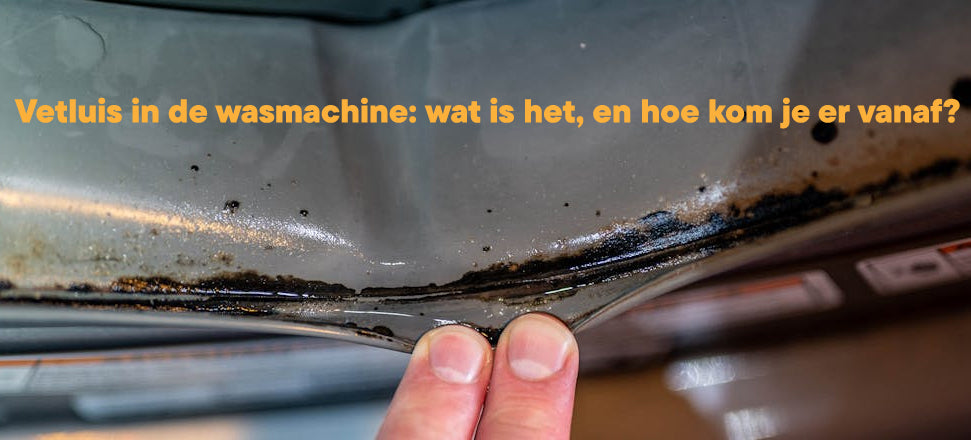
Grease in the Washing Machine: The Complete Guide
Does your laundry smell musty or do you see gray, slimy residue in the rubber sleeve? Chances are you're dealing with grease lice in your washing machine . This guide explains exactly what grease lice are, how to remove them, and how to prevent them in the future.
What is grease lice?
Grease lice aren't actually "lice," but rather a sticky biofilm of soap residue , skin oils, dirt, and microorganisms. They cling to the drum, rubber seal, soap dish, and pipes. This film causes your laundry to smell musty, especially after low-temperature washes.
The bottom line: too much detergent + too low a temperature + too little rinsing = buildup . The solution is: correct dosing , regular hotter washes/maintenance , and occasional manual cleaning .
Want precisely dosed, plastic-free laundry? Check out our detergent strips or choose directly: Sea Breeze / Spring Blossom .
Symptoms & causes
- Musty smell from machine or clothes, especially after opening the door.
- Gray/brown deposits in rubber sleeve or soap dish.
- Small black dots (biofilm residue) on laundry.
- Too much detergent or fabric softener, low temperatures, often short programs.
- Poor ventilation : door/dosage drawer always closed → moisture remains.
Quick fix: remove grease lice in 10 steps
- Empty and bleed the appliance. Remove laundry. Unplug the appliance when performing maintenance.
- Clean the rubber cuff. Flip the rubber forward and wipe away any visible dirt with a soft cloth and lukewarm soapy water (possibly with a little dishwashing liquid). Rinse.
- Remove the soap container. Soak it in warm water, brush off any soap residue, and rinse thoroughly.
- Inlet and drawer slot. Clean with a bottle brush and cloth, ensuring all corners are clean.
- Lint filter/drain pump. Prepare a container, open it, remove any debris, and check for coins or hooks.
- Drum cloth. Wipe the inside of the drum and the glass door clean.
- Maintenance wash. Run an empty load of laundry at 60–90°C with a dishwasher detergent or according to the instructions. Never use chlorine bleach in combination with vinegar or other acids.
- Ventilate. Leave the door and drawer open afterwards until everything is dry.
- Check the odor. Is the smell gone? If not, repeat steps 2–7 and check the drain/drain hose.
- Set prevention. See the schedule in Prevention .
Tip: Use gloves when working and always follow the instructions provided by the manufacturer of your machine and cleaners.
Thorough cleaning: parts one by one
Soap dish
This is where most of the residue often accumulates. Remove the tray completely, soak it in warm water, and brush the openings and corners. Also clean the drawer slot .
Rubber cuff (door seal)
Pull the rubber out, removing any lint or dirt. Clean with lukewarm water and a mild all-purpose cleaner. Rinse and dry to prevent mold growth.
Lint filter/drain pump
Open the valve (at the bottom), unscrew the cap, and collect the water. Remove any lint or foreign objects. Clean the housing and replace it.
Drum & pipes
Run an empty hot wash cycle (60–90°C) with a suitable cleaner. Repeat if necessary. This helps loosen biofilm in pipes and on the heating element.
Vinegar, baking soda & machine cleaners: what works?
- Machine cleaners are designed for limescale/soap residue and are safe to use according to the label.
- Vinegar can help with limescale odors, but use sparingly and never with chlorine products. Check the instructions: some manufacturers advise against vinegar due to its rubber properties.
- Baking soda (crystalline soda) dissolves grease and soap residue in hot washes. Do not use on wool or silk, and rinse thoroughly.
Dosage & detergent: how to prevent build-up
Too much liquid detergent and fabric softener leaves a residue. Dose based on water hardness and soiling . Precise dosing is easy with detergent strips : ½ strip for small or lightly soiled loads, 1 strip for a normal full load.
Try our fragrances: Sea Breeze or Spring Blossom .
Towels & sportswear: special attention
Towels retain a lot of moisture and can quickly develop a musty smell. Wash them at 60°C (140°F) and dry thoroughly. Sportswear often contains synthetic fibers that trap odors: choose a sports cycle and rinse thoroughly. See also our subblog on removing grease lice from towels .
Prevention: simple maintenance schedule
- After every wash: leave the door and drawer ajar and rub the cuff dry.
- Weekly: one wash at 60 °C (towels/bed linen).
- Monthly: empty maintenance wash 60–90 °C and clean drawer/cuff.
- Always dose correctly: avoid overdosing with detergent strips .
- Be frugal with fabric softener: preferably not; it increases build-up.
Want to get started right away? Discover all Simplewas wax strips or choose Sea Breeze / Spring Blossom right away.
FAQ about grease lice
What exactly is grease lice?
A biofilm of soap residue, skin oils and microorganisms that adheres to machine parts and causes a musty odor.
How do I get rid of grease lice quickly?
Clean the cuff, soap dish, and filter, then run an empty hot wash cycle with a suitable cleaner. Ventilate and repeat if necessary.
Does vinegar help against grease lice?
Vinegar can reduce limescale and odor, but use it sparingly and never with chlorine bleach. Consult your machine's manual.
How do I prevent it from coming back?
Correct dosage, regular washing at 60°C, monthly maintenance, leave the door/drawer open and use little to no fabric softener.

